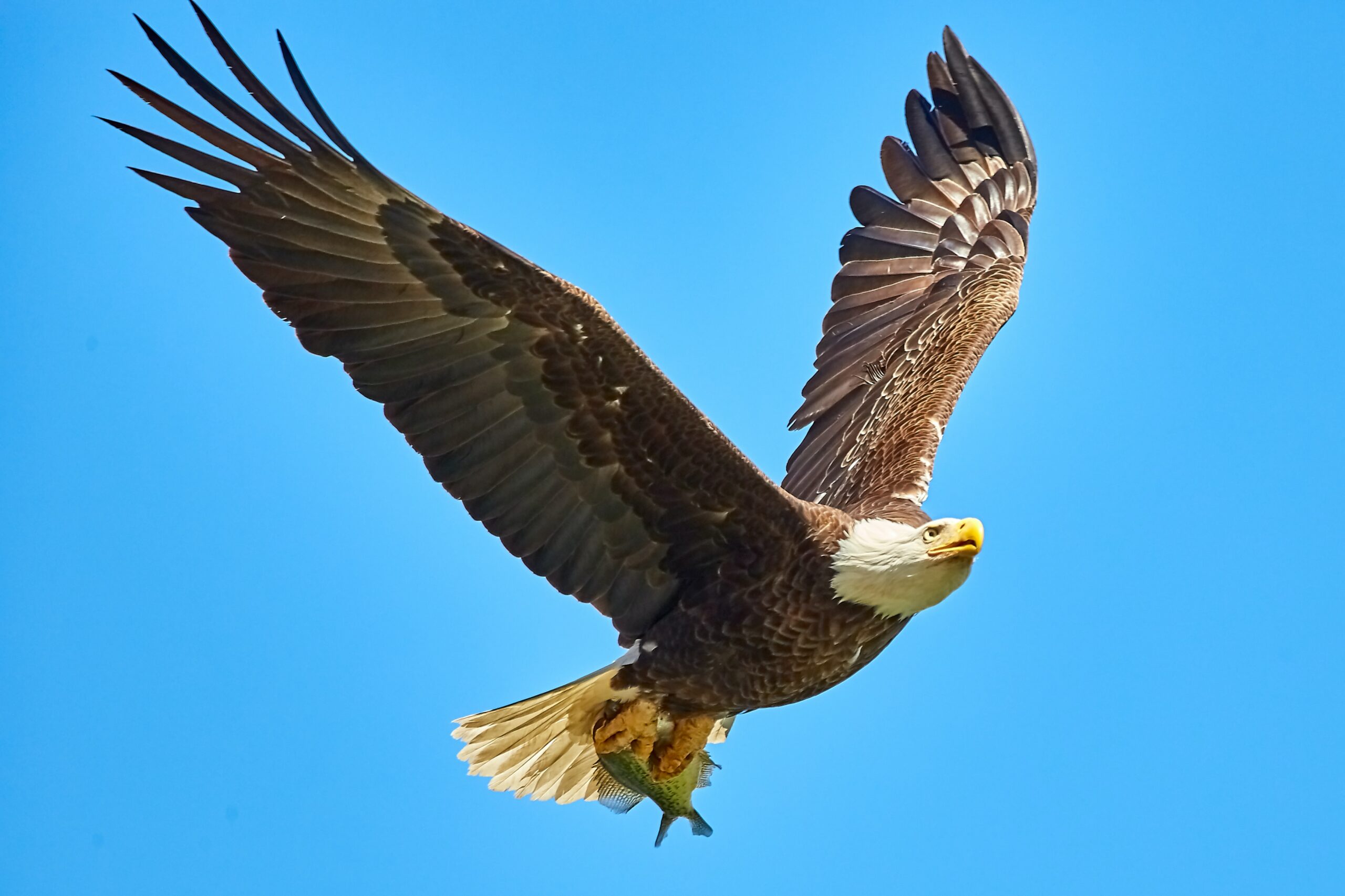Welcome to the awe-inspiring world of the majestic raptors known as eagles. These magnificent birds that command the skies with their powerful wings and keen vision belong to the animal kingdom’s order Accipitriformes and the family Accipitridae.
Eagles are revered for their grace, strength, and predatory prowess. Soar with us on the wings of eagles as we explore the diverse realm of the majestic birds, including their various types, popular species, size variations, feeding habits, reproduction, lifespan, unique characteristics, and the distinctions between eagles and hawks.
Eagles are large birds of prey characterized by their sturdy build, broad wings, and sharp curved beaks. They possess exceptional eyesight, enabling them to spot prey from great distances. With talons designed for capturing and gripping, eagles are highly skilled hunters.
These magnificent birds showcase a range of colors and patterns in their plumage, often exhibiting sexual dimorphism, where males and females may have different appearances.
Types of Eagles:
There are approximately 60 species of eagles found worldwide. Some popular types include the Bald Eagle, Golden Eagle, and the Africa Fish Eagle, which resembles the Bald Eagle of North America. Here is a bird’s eye view of 10 of the more popular species:
Bald Eagle: The Bald Eagle is an iconic symbol of the United States, recognized for its distinctive white head and tail contrasting with a dark brown body. It is a skilled fisher and can be found near bodies of water throughout North America. The Bald Eagle is known for its soaring flights and impressive size, with a wingspan of up to 7.5 feet (2.3 meters).
Golden Eagle: The Golden Eagle is one of the largest and most widespread eagle species, found in North America, Europe, Asia, and North Africa. It boasts a golden-brown plumage and a powerful beak. Golden Eagles are formidable hunters, preying on a variety of mammals, birds, and reptiles. They are renowned for their agility and swift flight.
Harpy Eagle: The Harpy Eagle is known for its striking appearance, with a distinctive crest of feathers on its head. It is found in the tropical rainforests of Central and South America. The Harpy Eagle is one of the largest and most powerful eagles, possessing formidable talons for capturing and subduing prey, which includes monkeys and sloths.
African Fish Eagle: The African Fish Eagle is a majestic species found near freshwater bodies throughout sub-Saharan Africa. It has a striking appearance, with a white head, chestnut body, and a distinctive call that resonates across its territory. African Fish Eagles are skilled fishermen, swooping down to catch fish from the water’s surface.
Philippine Eagle: The Philippine Eagle, also known as the Monkey-eating Eagle, is one of the world’s largest and rarest eagle species. It is endemic to the Philippines and known for its magnificent appearance, including a shaggy crest and striking blue eyes. These eagles primarily feed on monkeys, flying lemurs, and other small mammals.
White-tailed Eagle: The White-tailed Eagle, also called the Sea Eagle, is found in coastal regions and freshwater habitats of Eurasia and North America. With a wingspan of up to 8 feet (2.5 meters), it is one of the largest eagle species. White-tailed Eagles are skilled hunters, preying on fish, birds, and mammals near water bodies.
Steller’s Sea Eagle: Steller’s Sea Eagle is another remarkable large eagle species found primarily in Russia and neighboring countries. It has a distinctive appearance, with abold black-and-white plumage, a massive beak, and a prominent crest. Steller’s Sea Eagles primarily feed on fish, especially salmon, which they catch near coastal areas.
Martial Eagle: The Martial Eagle is a formidable predator found in sub-Saharan Africa. It is one of the largest and most powerful eagles in Africa, known for its incredible strength and aerial agility. Martial Eagles prey on a variety of animals, including small antelopes, hares, and birds.
Steppe Eagle: The Steppe Eagle is a migratory species that breeds in the grasslands of Eurasia and winters in Africa. It has a brown plumage and a distinctive white patch on its back. Steppe Eagles have a varied diet, feeding on small mammals, birds, reptiles, and even carrion.
Spotted Eagle: The Spotted Eagle is a medium-sized eagle species found in Europe and Asia. It displays a mottled brown plumage with white spots, giving it its name. These eagles primarily feed on small mammals, reptiles, and birds, and they often inhabit forested areas.
Unique Characteristics of Eagles:
Eagles possess several unique characteristics that distinguish them from other birds. They have excellent eyesight, enabling them to spot prey from great distances and accurately navigate their surroundings. Eagles also have strong and sharp talons for capturing and grasping their prey. Their powerful wings allow them to soar and glide effortlessly through the air, exhibiting impressive aerial acrobatics.
Summary
Eagles, with their majestic presence, keen vision, and formidable hunting skills, are captivating birds that command admiration and respect. From the iconic Bald Eagle to the impressive Philippine Eagle, each species showcases unique characteristics and adaptations that allow them to thrive in their respective habitats.
As apex predators, eagles play a vital role in maintaining ecological balance and serve as indicators of the health of their ecosystems. Let us appreciate and protect these magnificent raptors, ensuring their habitats and populations endure for generations to come, and allowing the skies to continue to grace us with their awe-inspiring presence.



































































